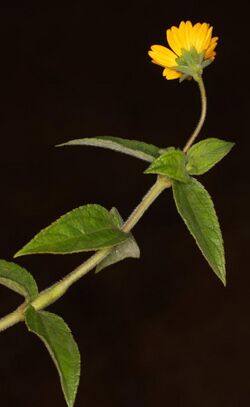Biology:Aspilia africana
| Haemorrhage plant | |
|---|---|

| |
| Scientific classification | |
| Kingdom: | Plantae |
| Clade: | Tracheophytes |
| Clade: | Angiosperms |
| Clade: | Eudicots |
| Clade: | Asterids |
| Order: | Asterales |
| Family: | Asteraceae |
| Genus: | Aspilia |
| Species: | A. africana
|
| Binomial name | |
| Aspilia africana (Pers.) C.D.Adams[1]
| |
Aspilia africana, also known as the haemorrhage plant or wild sunflower,[2] is one of about 50 species of the genus Aspilia.
Description
Aspilia africana is a semi-woody herb from a perennial woody root-stock to 25–130 cm high. Leaves are 4–12 cm long and lanceolate. The fruit are 3–3.5mm long achenes.[1]
It is very polymorphic with at least four varieties recognized.
Distribution and habitat
It is widely distributed across tropical Africa, occurring on grasslands, woodlands, forest margins, and abandoned cultivated zones.[1]
Traditional medicine
Aspilia africana has been classified as a low toxicity plant and has been used in traditional African medicine to treat wounds.[2] Its leaves are taken as an infusion by women after childbirth.[2] There is no scientific evidence that it has any medicinal properties.
References
- ↑ 1.0 1.1 1.2 "Aspilia africana (Pers.) C.D.Adams", Plants of the World Online (Royal Botanic Gardens, Kew), https://powo.science.kew.org/taxon/urn:lsid:ipni.org:names:180333-1, retrieved 2019-05-02
- ↑ 2.0 2.1 2.2 Komakech; Matsabisa; Kang (21 Jan 2019). "The Wound Healing Potential of Aspilia africana (Pers.) C. D. Adams (Asteraceae)". Evidence-Based Complementary and Alternative Medicine 2019: 1–12. doi:10.1155/2019/7957860. PMID 30800171.
External links
Wikidata ☰ {{{from}}} entry
 |

